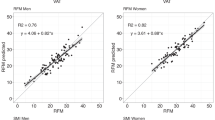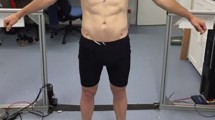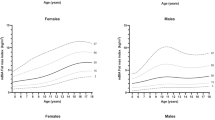Abstract
Background:
Body mass index (BMI) cut-offs associated with increased risk of diabetes and cardiovascular disease differ between European and Asian populations, and among Asian populations. Within-population and ethnic variability in body shape has likewise been linked with variability in cardiovascular risk in western settings.
Objectives:
To explore differences between Thai and White UK adults in body shape and its associations with height, age and BMI.
Methods:
Data on weight and body shape by 3-D photonic scanning from National Sizing Surveys of UK (3542 men, 4130 women) and Thai (5889 men, 6499 women) adults aged 16–90 years, using a common protocol and methodology, were analysed.
Results:
Thai adults in both sexes had significantly smaller body girths than UK adults after adjusting for age and height. Matching for BMI, and adjusting for height and age, Thais in both sexes tended to have similar or greater limb girths, but significantly smaller torso girths (especially waist and hip) than UK individuals. These results were replicated within narrow BMI bands at ∼20 and ∼25 kg m−2. Shape-age associations also differed between the populations.
Discussion:
Young Thai adults have a significantly slighter physique than White UK adults, with a less central distribution of body weight. However these differences reduce with age, especially in males. The 3-D photonic scanning provides detailed digital anthropometric data capable of monitoring between- and within-individual shape variability. The technology merits further application to investigate whether variability in body shape is more sensitive to metabolic risk than BMI within and between-populations.
This is a preview of subscription content, access via your institution
Access options
Subscribe to this journal
Receive 12 print issues and online access
$259.00 per year
only $21.58 per issue
Buy this article
- Purchase on Springer Link
- Instant access to full article PDF
Prices may be subject to local taxes which are calculated during checkout



Similar content being viewed by others
References
Yusuf S, Hawken S, Ounpuu S, Bautista L, Franzosi MG, Commerford P et al. Obesity and the risk of myocardial infarction in 27 000 participants from 52 countries: a case-control study. Lancet 2005; 366: 1640–1649.
Empana JP, Ducimetiere P, Charles MA, Jouven X . Sagittal abdominal diameter and risk of sudden death in asymptomatic middle-aged men: the Paris Prospective Study I. Circulation 2004; 110: 2781–2785.
Snijder MB, Dekker JM, Visser M, Bouter LM, Stehouwer CD, Yudkin JS et al. Trunk fat and leg fat have independent and opposite associations with fasting and postload glucose levels: the Hoorn study. Diabetes Care 2004; 27: 372–377.
Snijder MB, Zimmet PZ, Visser M, Dekker JM, Seidell JC, Shaw JE . Independent and opposite associations of waist and hip circumferences with diabetes, hypertension and dyslipidemia: the AusDiab Study. Int J Obes Relat Metab Disord 2004; 28: 402–409.
Han TS, McNeill G, Seidell JC, Lean ME . Predicting intra-abdominal fatness from anthropometric measures: the influence of stature. Int J Obes Relat Metab Disord 1997; 21: 587–593.
Brambilla P, Bedogni G, Moreno LA, Goran MI, Gutin B, Fox KR et al. Crossvalidation of anthropometry against magnetic resonance imaging for the assessment of visceral and subcutaneous adipose tissue in children. Int J Obes (Lond) 2006; 30: 23–30.
Turcato E, Bosello O, Di FV, Harris TB, Zoico E, Bissoli L et al. Waist circumference and abdominal sagittal diameter as surrogates of body fat distribution in the elderly: their relation with cardiovascular risk factors. Int J Obes Relat Metab Disord 2000; 24: 1005–1010.
Lee CM, Huxley RR, Wildman RP, Woodward M . Indices of abdominal obesity are better discriminators of cardiovascular risk factors than BMI: a meta-analysis. J Clin Epidemiol 2008; 61: 646–653.
Treleaven P, Wells JC . 3D Body Scanning and Healthcare Applications. Computer 2007; 40: 28–34.
Wells JC, Ruto A, Treleaven P . Whole-body three-dimensional photonic scanning: a new technique for obesity research and clinical practice. Int J Obes (Lond) 2008; 32: 232–238.
Wang J, Gallagher D, Thornton JC, Yu W, Horlick M, Pi-Sunyer FX . Validation of a 3-dimensional photonic scanner for the measurement of body volumes, dimensions, and percentage body fat. Am J Clin Nutr 2006; 83: 809–816.
Lin JD, Chiou WK, Weng HF, Fang JT, Liu TH . Application of three-dimensional body scanner: observation of prevalence of metabolic syndrome. Clin Nutr 2004; 23: 1313–1323.
Wells JC, Griffin L, Treleaven P . Independent changes in female body shape with parity and age: a life-history approach to female adiposity. Am J Hum Biol 2010; 22: 456–462.
McKeigue PM . Metabolic consequences of obesity and body fat pattern: lessons from migrant studies. Ciba Found Symp 1996; 201: 54–64.
Ehtisham S, Crabtree N, Clark P, Shaw N, Barrett T . Ethnic differences in insulin resistance and body composition in United Kingdom adolescents. J Clin Endocrinol Metab 2005; 90: 3963–3969.
Zhu S, Heymsfield SB, Toyoshima H, Wang Z, Pietrobelli A, Heshka S . Race-ethnicity-specific waist circumference cutoffs for identifying cardiovascular disease risk factors. Am J Clin Nutr 2005; 81: 409–415.
Park YW, Allison DB, Heymsfield SB, Gallagher D . Larger amounts of visceral adipose tissue in Asian Americans. Obes Res 2001; 9: 381–387.
Deurenberg P, Deurenberg-Yap M, Guricci S . Asians are different from Caucasians and from each other in their body mass index/body fat per cent relationship. Obes Rev 2002; 3: 141–146.
Yajnik CS, Yudkin JS . The Y-Y paradox. Lancet 2004; 363: 163.
McKeigue PM, Shah B, Marmot MG . Relation of central obesity and insulin resistance with high diabetes prevalence and cardiovascular risk in South Asians. Lancet 1991; 337: 382–386.
Park YW, Zhu S, Palaniappan L, Heshka S, Carnethon MR, Heymsfield SB . The metabolic syndrome: prevalence and associated risk factor findings in the US population from the Third National Health and Nutrition Examination Survey, 1988–1994. Arch Intern Med 2003; 163: 427–436.
Mensah GA, Mokdad AH, Ford ES, Greenlund KJ, Croft JB . State of disparities in cardiovascular health in the United States. Circulation 2005; 111: 1233–1241.
Palaniappan L, Wang Y, Fortmann SP . Coronary heart disease mortality for six ethnic groups in California, 1990–2000. Ann Epidemiol 2004; 14: 499–506.
Molarius A, Seidell JC, Sans S, Tuomilehto J, Kuulasmaa K . Educational level, relative body weight, and changes in their association over 10 years: an international perspective from the WHO MONICA Project. Am J Public Health 2000; 90: 1260–1268.
Pickett KE, Kelly S, Brunner E, Lobstein T, Wilkinson RG . Wider income gaps, wider waistbands? An ecological study of obesity and income inequality. J Epidemiol Community Health 2005; 59: 670–674.
Consultation WE . Appropriate body-mass index for Asian populations and its implications for policy and intervention strategies. Lancet 2004; 363: 157–163.
Lin JD, Chiou WK, Weng HF, Tsai YH, Liu TH . Comparison of three-dimensional anthropometric body surface scanning to waist-hip ratio and body mass index in correlation with metabolic risk factors. J Clin Epidemiol 2002; 55: 757–766.
Wells JC, Treleaven P, Cole TJ . BMI compared with 3-dimensional body shape: the UK National Sizing Survey. Am J Clin Nutr 2007; 85: 419–425.
Douros I, Dekker L, Buxton BF . Reconstruction of the surface of the human body from 3D scanner data using B-splines. Proc SPIE 1999; 3640: 234–245.
Treleaven PC . Sizing us up. IEEE Spectrum 2004; 41: 28–31.
Lohsoonthorn V, Lertmaharit S, Williams MA . Prevalence of metabolic syndrome among professional and office workers in Bangkok, Thailand. J Med Assoc Thai 2007; 90: 1908–1915.
Worachartcheewan A, Nantasenamat C, Isarankura-Na-Ayudhya C, Pidetcha P, Prachayasittikul V . Lower BMI cutoff for assessing the prevalence of metabolic syndrome in Thai population. Acta Diabetol 2010; 47 (Suppl 1): 91–96.
Wells JC, Cole TJ, Bruner D, Treleaven P . Body shape in American and British adults: between-country and inter-ethnic comparisons. Int J Obes (Lond) 2008; 32: 152–159.
Heymsfield SB, Martin-Nguyen A, Fong TM, Gallagher D, Pietrobelli A . Body circumferences: clinical implications emerging from a new geometric model. Nutr Metab (Lond) 2008; 5: 24.
Author information
Authors and Affiliations
Corresponding author
Ethics declarations
Competing interests
The authors declare no conflict of interest.
Rights and permissions
About this article
Cite this article
Wells, J., Treleaven, P. & Charoensiriwath, S. Body shape by 3-D photonic scanning in Thai and UK adults: comparison of national sizing surveys. Int J Obes 36, 148–154 (2012). https://doi.org/10.1038/ijo.2011.51
Received:
Revised:
Accepted:
Published:
Issue Date:
DOI: https://doi.org/10.1038/ijo.2011.51
Keywords
This article is cited by
-
Associations between 3D surface scanner derived anthropometric measurements and body composition in a cross-sectional study
European Journal of Clinical Nutrition (2023)
-
The effect of visceral obesity on clinicopathological features in patients with endometrial cancer: a retrospective analysis of 200 Chinese patients
BMC Cancer (2016)
-
Body shape and size in 6-year old children: assessment by three-dimensional photonic scanning
International Journal of Obesity (2016)



